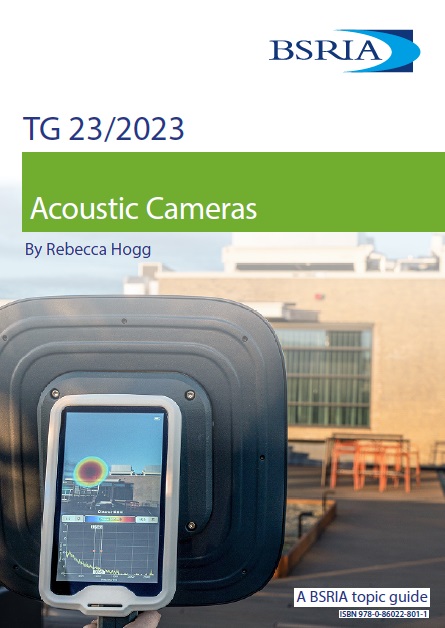Acoustic Cameras (TG 23/2023)
Acoustic Cameras (TG 23/2023) was written by Rebecca Hogg and published by BSRIA in July 2023.
This topic guide provides a broad overview of acoustic cameras – a technology which can be used to visually identify noise sources. It explains how an acoustic camera works, some of the applications of acoustic cameras, and the advantages and disadvantages of using acoustic cameras over other technologies.
Traditionally a sound level meter is used to measure noise levels, in decibels. Investigating noise sources can be achieved by systematically turning on and off noise sources and by using other investigation techniques. When troubleshooting building services systems, there are other investigation techniques that can be used such as vibration monitoring, air and water flow rate measurements, and pressure measurements. When using these, it may also be necessary to turn off systems and dismantle components. The advantage of using an acoustic camera over such investigation techniques is that an acoustic camera does not require systems to be broken into or sensors to be physically attached to a system.
An acoustic camera incorporates an array of microphones. It builds up an image by processing the information received at each of the microphones in the array, which all receive sound waves from the same source at slightly different times. The image produced uses colours to represent sound pressure levels. Typically, bright colours such as yellow are used to represent areas producing the most intense sound whereas darker colours such as purple are used to represent areas producing the least intense sound. The specific colours used, and the range of sound pressure levels represented by these colours, can be selected in the software used by acoustic cameras.
You can download the guide at: https://www.bsria.com/uk/product/rgooar/acoustic_cameras_tg_232023_a15d25e1/
--BSRIA
[edit] Related articles on Designing Buildings
Featured articles and news
Infrastructure that connect the physical and digital domains.
Harnessing robotics and AI in challenging environments
The key to nuclear decommissioning and fusion engineering.
BSRIA announces Lisa Ashworth as new CEO
Tasked with furthering BSRIA’s impressive growth ambitions.
Public buildings get half a million energy efficiency boost
£557 million to switch to cleaner heating and save on energy.
CIOB launches pre-election manifesto
Outlining potential future policies for the next government.
Grenfell Tower Inquiry announcement
Phase 2 hearings come to a close and the final report due in September.
Progress from Parts L, F and O: A whitepaper, one year on.
A replicated study to understand the opinion of practitioners.
ECA announces new president 2024
Electrical engineer and business leader Stuart Smith.
A distinct type of countryside that should be celebrated.
Should Part O be extended to existing buildings?
EAC brands heatwave adaptation a missed opportunity.
Definition of Statutory in workplace and facilities management
Established by IWFM, BESA, CIBSE and BSRIA.
Tackling the transition from traditional heating systems
59% lack the necessary information and confidence to switch.
The general election and the construction industry
As PM, Rishi Sunak announces July 4 date for an election.
Eco apprenticeships continue help grow green workforce
A year after being recognised at the King's coronation.
Permitted development rights for agricultural buildings
The changes coming into effect as of May 21, 2024.























